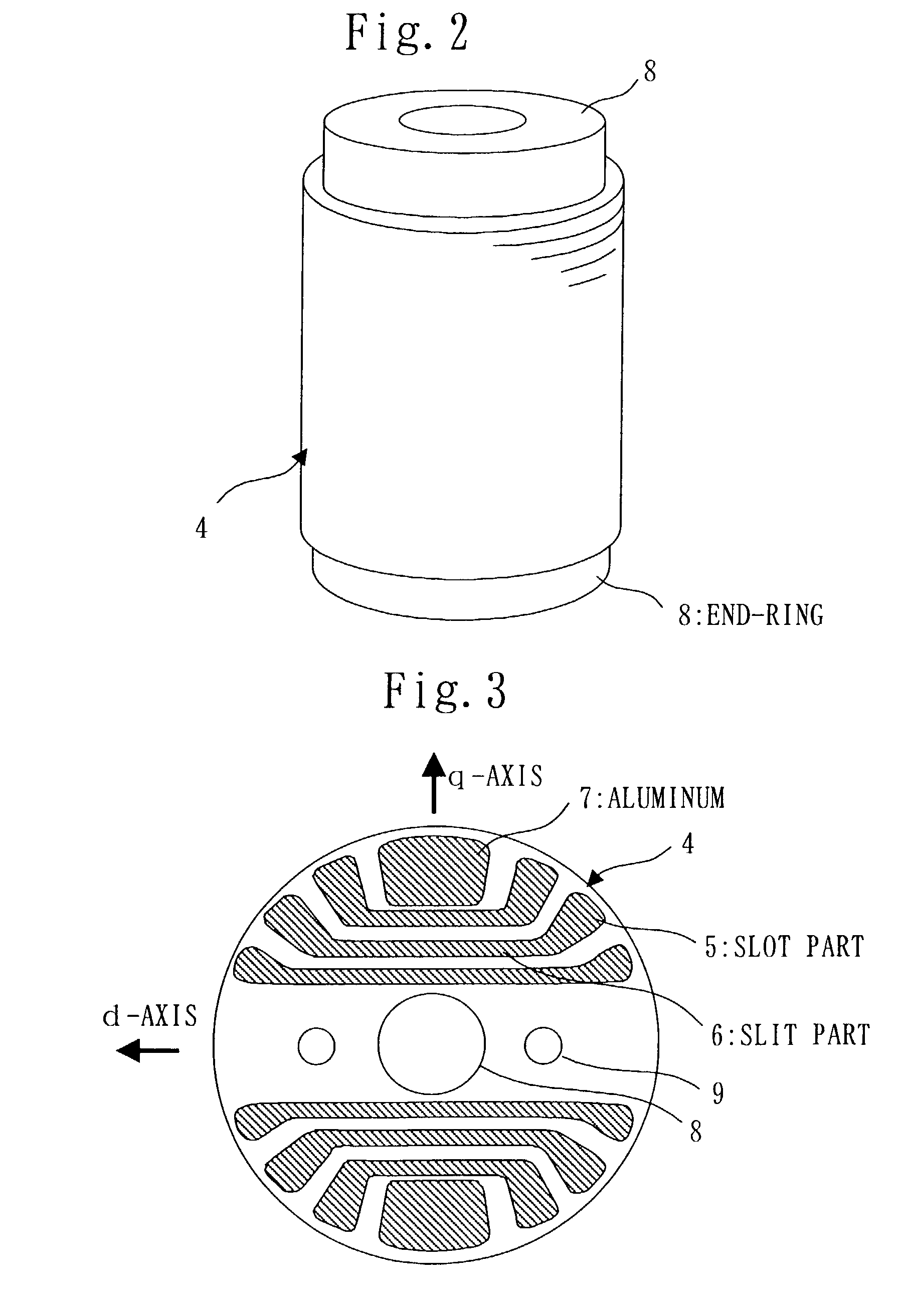Rotor of a synchronous induction electric motor
a synchronous induction electric motor and synchronous induction technology, applied in the direction of positive displacement liquid engine, magnetic circuit rotating parts, magnetic circuit shape/form/construction, etc., can solve the problems of output falling, efficiency decreasing, and difficulty in providing holes in slit parts, so as to increase the magnetic resistance and efficiency.
- Summary
- Abstract
- Description
- Claims
- Application Information
AI Technical Summary
Benefits of technology
Problems solved by technology
Method used
Image
Examples
embodiment 1
[0030]FIGS. 1 through 4 illustrate Embodiment 1. FIG. 1 shows a transverse sectional view of a stator and a rotor of a synchronous induction electric motor, FIG. 2 shows a perspective view of the rotor of the synchronous induction electric motor, FIG. 3 shows a transverse sectional view of the rotor of the synchronous induction electric motor, and FIG. 4 shows a transverse sectional view of the rotor of the synchronous induction electric motor where a non-filling part is formed at a slit.
[0031]In FIGS. 1 through 3, a stator 1 of the synchronous induction electric motor, a plurality of slots 2 provided at the inner circumferential side of the stator 1, windings 3, and a rotor 4 are provided. The winding 3 is wound at each of the plurality of slots 2 in order to generate magnetic flux for rotating the rotor 4. The rotor 4 is located inside the stator 1 and includes a slot part 5 for generating induction torque and a slit part 6 for generating reluctance torque. The slot part 5 and the...
embodiment 2
[0040]FIG. 5 shows a transverse sectional view of a rotor of a synchronous induction electric motor according to Embodiment 2. As shown in FIG. 5, the non-filling part 10 is provided in the slit part 6 which is the closest to the center of the rotor 4.
[0041]As structured above, the amount of aluminum of the end-ring 8 which functions as a rotor of the induction electric motor is not reduced. Therefore, it is possible to make secondary resistance of the rotor small and torque which is as an induction electric motor at a small slide area large. Accordingly, the operation led to synchronous operation from motor starting can be stably performed.
[0042]Moreover, when the synchronous induction electric motor is used for the sealed type compressor, rotation velocity of the non-filling part 10, which functions as a gas vent hole, becomes slow in the case of the non-filling part 10 being located close to the center of the rotor. Therefore, it is possible to reduce pressure loss of refrigerant...
embodiment 3
[0044]FIG. 6 shows a transverse sectional view of a rotor of a synchronous induction electric motor according to Embodiment 3. As shown in FIG. 6, two gas vent holes 9 in the shape of an oval are provided in the direction of the d-axis and in the radial direction, and each of the gas vent holes is in the shape of an oval and a long hole along the d-axis direction and the radial direction.
[0045]By dint of the structure described above, the increase of magnetic resistance in the direction of the d-axis at the portion which contributes to the reluctance torque generated by providing the gas vent hole 9 can be suppressed as much as possible. Then, the decrease of the inductance Ld in the direction of the d-axis generated by using the windings in the stator can also be suppressed as much as possible. Consequently, the reluctance torque becomes large, which makes the synchronous induction electric motor efficient. Moreover, since the torque can be large by a rotor whose height of the roto...
PUM
 Login to View More
Login to View More Abstract
Description
Claims
Application Information
 Login to View More
Login to View More - R&D
- Intellectual Property
- Life Sciences
- Materials
- Tech Scout
- Unparalleled Data Quality
- Higher Quality Content
- 60% Fewer Hallucinations
Browse by: Latest US Patents, China's latest patents, Technical Efficacy Thesaurus, Application Domain, Technology Topic, Popular Technical Reports.
© 2025 PatSnap. All rights reserved.Legal|Privacy policy|Modern Slavery Act Transparency Statement|Sitemap|About US| Contact US: help@patsnap.com



